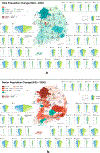Super Aging in South Korea Unstoppable but Mitigatable: A Sub-National Scale Population Projection for Best Policy Planning
- PMID: 34222615
- PMCID: PMC8248505
- DOI: 10.1007/s40980-020-00061-8
Super Aging in South Korea Unstoppable but Mitigatable: A Sub-National Scale Population Projection for Best Policy Planning
Abstract
This research portrays the spatial and temporal progression of super-aging in regions throughout South Korea. Using a single-year population projection considering gross domestic migration, this research identifies which regions will shortly become a super-aged society. A cohort-component method with a migrant pool model is applied. The county-level national population registration data (2000-2018) are aggregated into 37 regions for the model run. In 2020, 16 rural regions will become super-aged societies. By 2029, all 37 regions, including the metropolitan areas, will join the group, with Sejong, the administrative capital, being the last to enter. In brief, the rural areas become super-aged earlier than the metropolitan areas, and within a decade, those 65 years old or older will make up the majority of the national population. Among all the metropolitan areas, Busan, the largest harbor city, will be the first to be super-aged in 2023. Sejong will experience the most radical change between 2020 and 2050. The research outcomes demonstrate that demographic changes in the rural and metropolitan areas are different; hence, the recent population policies, such as promoting fertility, may not work in the rural areas as they have already lost their population momentum due to the extreme and ongoing urbanization throughout the nation. The unstoppable aging will pose adverse effects on future citizens (who are mostly senior) both financially and medically. An increase in health care expenditure and a nationwide blood shortage for transfusion are anticipated, for example.
Keywords: Aging; Cohort component method; Migrant pool model; Population projection; Super-aged society; Time-series analysis.
Figures





References
-
- Baker J, Swanson DA, Tayman J, & Tedrow LM (2017). Cohort change ratios and their applications. Cham: Springer.
-
- Bloomberg. (2019). South Korea set to break own record on world’s lowest birth rate. November 27.
-
- Chang C, Bae JS, & Seol A (2019). A study on population change and projection in Korea mountainous area. Journal of Korean Forest Society, 25(4), 99–107.
-
- Cho D, & Lee S (2011). Population projections for Busan using a biregional cohort-component method. Journal of the Korean Geographical Society, 46(2), 212–232.
-
- Choe MK, & Retherford RD (2009). The contribution of education to South Korea’s fertility decline to ‘lowest-low’ level. Asian Population Studies, 5(3), 267–288.
Grants and funding
LinkOut - more resources
Full Text Sources
